This year has been the "endless summer", day after day of hot sunny weather without rain, not even getting much in the way of thunderstorms. Once the soil reaches a certain level of dryness, where even trees and shrubs show the effects of drought, it becomes an uphill battle trying to resuscitate them by watering; a hose can barely begin to keep pace (and not to mention the water bans, restricted to watering every other day, which isn't too bad). The soil can become so hard, dry and dusty, that it reaches an "unwettable" state by actually repelling water.
Some plants cope just fine with the drought, others of course, do not. Has anyone used any techniques to help the more moisture sensitive plants stay hydrated? I was thinking about doing the following, I wonder if it would work or whether it would be a waste of time:
Take 2-liter soda bottles and cut off the bottom ends. Drill a few small holes in the caps, them screw them back on. Submerge a few open-ended bottles into the ground around water-sensitive plants (such as Kirengoshoma). Fill the bottle with coarse gravel, and cover with normal coarse-grade bark or stone mulch so that they're not visible. The idea is, after a watering "event" by hose, rain, or thunderstorm, the inverted open-ended bottles would collect water, and the reservoir of water could slowly trickle into the soil. The sheer fact the open-ended bottles would collect and redirect water downwards versus the inevitable run-off during brief downpours and the aforementioned unwettable soil states, I think could be an advantage.
Any other techniques?
Comments
Re: Combating drought in the garden
it would seem that almost the same effect could be done more simply by digging depressions in the soil surface, line with a permeable landscape cloth, or plastic with some holes, and fill with a coarse medium.
Re: Combating drought in the garden
You have my sympathies, Mark.
Perhaps to combat the runoff problem, it might help to make a small soil berm around some of the needier plants? Water might then have a better chance of soaking in, rather than running off, whether from watering or from rain... ? I suppose it might not be any more disruptive than the underground reservoir idea that you are thinking of.
Re: Combating drought in the garden
What if you dig in such drainage pipes they use to drain moist soil but use both ends up? All water you have you pour into it and the water will percolate into the soil. You can also cover the soil with a sheet of plastic that drains towards the ends of the pipe. Then all the water that fell here will reach the deeper layers of soil. You can of course cover the plastic sheet with gravel or something. The plastic sheet will reduce the evaporating too.
At my summerhouse we experience drought in May and June and the soil become like fat - expelling water. It takes months to moisten it throughout. I mix in sand to help absorb water.
Re: Combating drought in the garden
You have my sympathies, Mark.
Perhaps to combat the runoff problem, it might help to make a small soil berm around some of the needier plants? Water might then have a better chance of soaking in, rather than running off, whether from watering or from rain... ? I suppose it might not be any more disruptive than the underground reservoir idea that you are thinking of.
I have tried, halfheartedly, making bermed rings around plants. Since most of my property is sloped, the bermed rings tend to disappear over time, from natural settlement, runoff during large rain events, and when built-up around a young tree in my lawn areas, the tractor mower "blower hood" hits and flattens the raised areas. There are times too, like in late winter and spring, when a bermed "dish" around a plant makes for too much moisture, and I tend to err on the side of better drainage.
It's just when one gets a prolonged drought, as we have this year, and with predictions that this will become more commonplace, that I must think harder about drought-proofing some of the more needy plants.
Even some trees are now yellowing and shedding up to 50% of their leaves, many Magnolias, Halesia, my 20 year-old Katsura tree (Cercidiphyllum japonicum), most Hydrangeas look near death, etc. Fortunately, at long last we had a thunderstorm this afternoon, and it poured for 30 minutes, hallelujah! It helped bring the heat down from 92 F (33-34 C) to a more bearable lower steam heat. Now, if only I had some of those contrivances I threaten to make in place to redirect some of the runoff water into the ground.
And Trond, I am indeed doing as you suggest... after planting one area 5-6 years ago, a 2-3' high berm with unamended rocky-silty-clay soil, which becomes frustratingly "unwettable" as water just runs right off the dusty water-repellent surface layer, I now mix in coarse decomposed pine back mulch into any native soil before planting it. I would use sand, but it's heavy and expensive to buy, so I'm going with coarse organics instead. The older berm garden, mostly planted with Epimedium, is now scheduled for a makeover, to resolve the unwettable soil situation.
Re: Combating drought in the garden
Hi Mark,
"welcome to my world" is what I would've said before this winter when it would appear (touch wood!) that our 10 year drought has finally broken.
We've tried a lot of these startegies to combat the drought to keep things alive and green - not much would be relevant to you in your vastly different climatic zone. (Steering towards "drought hardy" and xeric plantings is our major change - so no more buying magnolias and rhodies which simply fry up in our garden!)
However the best advice we found for young trees is the use of a perforated pipe being placed down to the root zone, so that any water is directed there to encourage the roots downwards rather than up towards the surface. We've also found that planting in mounds or berms really helps which seems counter intuitive but it worked for a range of trees including Crataegus (Washington Thorn especially) and Koelreuteria paniculata the Golden Rain Tree. Mulch out to the "drip-line" is of course a great idea to get rid of competition from grass and weeds. Where we are the best mulch is coarse gravel or small rocks which can be taken right up to the trunk which you can't do with organic mulches such as straw.
The incorporation of organic matter into the soil is beneficial to improve the water-holding capacity but rain seems indispensible in the long run.
cheers
fermi
Re: Combating drought in the garden
Thanks Fermi, your comments derived from gardening in a climate that routinely deals with heat and drought, are useful indeed. One of the difficulties here is, that unlike gardening in a dry US State where is a given that rainfall will be low for the year, New England can run the gamut of weather trends, with non-standard "freak" years of extreme weather... too wet or too dry. So, it can be necessary to put initiatives in place to deal both with drought, and with extreme wet... depending on the year.
Five years ago, or was it six, we had record wet spring, followed by an extraordinarily very wet June and early July, and even though I'm up on a hill and garden on strongly sloped ground, the water table was so saturated that it oozed water out of the hillside for many weeks. Many of my raised beds are perpendicular to the downward slope, the seeping water saturated these beds from below, and I lost many bulbs (many alliums) from excessive moisture. I now build my raised beds to be parallel to the downward slope, to not impede any seepage flow.
As I am writing this message, I just received an automated telephone call from Town officials, changing our every-other-day water ban to a 100% water ban with fines imposed for anyone caught watering. Crap! Looks like a stealth watering-can-only protocol might be in order, for only the most dire of thirsty plants. Maybe when I go outside and work in the garden today, I'm start berming soil around those water-guzzlers. Although, looking around the garden, I am really taking note of those plants that seem completely unfazed by lack of water, maybe I need to concentrate on those.
Regarding trees, I do what you suggest, I maintain a mulched "tree ring" around all my ornamental trees, about equal to the drip line... this really does help. So far as Rhodies, I pretty much gave up on them when I first moved into my current location, just too hot, exposed, and dry on this hillside, but the Magnolias seems better able to cope... although mid to late summer drought can cause next year's flower buds to not develop properly.
Re: Combating drought in the garden
Again, what a tough situation.
Just a thought... what do you have in the way of water-collection systems? Given that you have an acreage, would installing a dugout (artificial and unattractive though they are, in their basic forms at least) be feasible/useful, in the longer run? (That is, assuming that your water laws allow rain collection... it is a bizarre notion, where they do not.)
You are probably way beyond us on this front, and it is a much different scale, I know, but just to mention it, in case it is useful to someone... for our 1/3 acre city lot, we have 3- 150 gallon plastic stock-watering troughs for rain-gathering. They sit in the utility area alongside the house, that is around the corner and thus not visible from the rest of the yard. The eavestroughs from most of the house and garage funnel into these; one trough drains into the adjacent trough for drainage off the house, the other is independent and drains the garage roof. Throw in a few goldfish for mosquito control, and it is great to have for watering in the greenhouse, and any spot watering and planting throughout the yard.
Re: Combating drought in the garden
The drought and hot weather continue, and now with a full 100% outdoor watering ban (with stiff fines imposed for anyone caught watering) I'm feeling desperate. Need to make decisions about what can collapse yet still survive, and plants that will most likely perish in extended drought conditions, the later I will stealthily and with great thrift hand water :-X. Two years ago, we had a drought period in late summer, where dozens upon dozens of Cimicifuga simplex atropurpurea where beginning to collapse, but I was able to water every other day, and most survived and flowered. Some of those plants out of easy reach of the water hose, did dry up completely and collapse, and to my surprise, they leafed out next spring as if nothing had happened.
Last year, we were in the path of thunderstorm after thunderstorm, getting a good drenching many times, and well spaced out, and the magnificent spires of Cimicifuga simplex atropurpurea topped out at 8'; they were spectacular, and the burnt cotton-candy scent filled the air. This year, even with hours upon hours of watering during the allowed every other day watering restriction, they were having a tough time. Now, most flowering stems are crisp and frazzled and falling over; I wonder if I should just cut off the stems and foliage altogether, thus conserving their thickened caudex and root system to resprout next year.
Today there was a threat of a thunderstorm, some brief cloudiness, but no precipitation. Drove down 1/2 mile to a farm stand to buy some corn, and the parking lot was full of big puddles, they got 10 minutes of rain!
I saved a couple of soda bottles to try and make some in-ground slow drip-irrigators, but my wife threw out the bottle caps. So, after drinking up a bottle of Ginger Ale (a "soft drink" or soda pop to those not in the USA), I made a drip irrigator. The holes drilled through the cap need to be very small and few. I cut the bottom off the plastic bottle, then dug a hole and plunged it next to Leucosceptrum stellipilum (Japanese Shrub Mint), a wonderful fall-blooming member of the mint family that does a good impression of a Hydrangea in leaf. The bottle was filled with gravel, plunged to slightly below ground level, and then covered with mulch. In a rain event, or even with hand watering, hopefully the open-ended rain/water catchment device will redirect water to the thirsty plant (4 photos show this process today). The last photo shows the plant earlier in the year, with attractive leaves. It flowers in Sept-Oct... will show pics later if it flowers again, or else show photos from previous years.
Re: Combating drought in the garden
Well done - it looks like that was accomplished with very little disturbance.
Off topic, but... Leucosceptrum stellipilum looks like quite an interesting thing to try - terrific if it would bloom early enough here to avoid being frozen off (and, as always, assuming hardiness, of course).
Re: Combating drought in the garden
Mark,
a 100% ban is pretty tough but virtually what we have at our place as we aren't on reticulated or "town" water! We collect all our own drinking water via the roof and it's stored in a couple of large (5,000gal) tanks. Water off the car-port roof is collected in smaller (11,000L) tanks which was all we had to use last year when the house tanks ran dry! We now also have a bore pump for watering the garden but prior to that water was in very short supply for the plants!
In Melbourne and many country towns watering was restricted to two hours twice a week but people eked out their allocation by saving shower/bath-water, the second rinse off the washing machine (also important to use a low sodium washing powder!) and even the water from rinsing the vegetables before cooking! As a Physio (read "Physical Therapist") I was constantly treating older clients who had strained their backs or shoulders from lugging around buckets of "grey water"!
cheers
fermi
Re: Combating drought in the garden
Mark,
a 100% ban is pretty tough but virtually what we have at our place as we aren't on reticulated or "town" water! We collect all our own drinking water via the roof and it's stored in a couple of large (5,000gal) tanks. Water off the car-port roof is collected in smaller (11,000L) tanks which was all we had to use last year when the house tanks ran dry! We now also have a bore pump for watering the garden but prior to that water was in very short supply for the plants!
In Melbourne and many country towns watering was restricted to two hours twice a week but people eked out their allocation by saving shower/bath-water, the second rinse off the washing machine (also important to use a low sodium washing powder!) and even the water from rinsing the vegetables before cooking! As a Physio (read "Physical Therapist") I was constantly treating older clients who had strained their backs or shoulders from lugging around buckets of "grey water"!
cheers
fermi
Fermi, your water situation certainly puts it all into perspective! If we had more than one summer in a row with dire drought conditions, I suppose many of us here would start getting serious about water conservation measures, and as gardeners, work hard towards improving soil conditions, mulches, and planting techniques (along with plant selection) that would be more in tune with surviving drought. But next year who knows, I could be starting a new topic called "combating excessive moisture in the garden". However, the prediction is that we're going to start seeing longer spring-summer seasons and more frequency of drought conditions.
When I think about soils, that is much of the problem. The location where the Leucosceptrum stellipilum is planted, is an area I filled over a 15 year span of time with plant debris, leaves, etc, the soil is basically the result of composting all those years, and it 1-2' deep of light porous organic soil. If there were more clay in the soil, I think water retention would be better.
In other spots, the silty fines in the soil become unwettable, especially when such soil is on a slope, water just runs off. Must try to create flatter or terraced planting to mitigate water runoff. For some collapsing plants, I'm now hand watering in an attempt to salvage them, I am digging a small hole just above the plant on the slope, then pouring water into the hole, allowing the water to permeate. Here's a photo of Paeonia japonica and Carex appalichica, where I dug a hole behind each and will be pouring water into the holes. Some parts of my garden are earmarked to be redone, because they are so problematically dry. I need to find a good amenable home for Carex appalachica, it's a fine-leaved beauty when growing in a spot it likes:
http://www.google.com/images?client=hp&expIds=17259,17315,23051,23628,23...
Re: Combating drought in the garden
Well done - it looks like that was accomplished with very little disturbance.
Off topic, but... Leucosceptrum stellipilum looks like quite an interesting thing to try - terrific if it would bloom early enough here to avoid being frozen off (and, as always, assuming hardiness, of course).
Lori, there are a number of Leucoceptrum varieties kicking around, including some variegated leaf forms, and a yellowish flowered species, L. japonicum. Leucosceptrum stellipilum has pink "bottle-brush" type of fuzzy wands very late in the season. Can't readily find pics from more recent years, but here are two photos of a younger plant flowering early November 2006. Perhaps these flower too late for your climate?
Re: Combating drought in the garden
Seems to be working, watering once a day, pouring the water into the submerged 2-liter soda bottle drip-irrigater, and the Leucosceptrum stellipilum plant has perked up quite well, as has the thirsty Heucherella hybrid growing right next to it. Next step, I'll be submerging two of these drip-irrigaters around a large plant of Kirengeshoma palmata, which always droops from insufficient moisture.
Re: Combating drought in the garden
It is interesting to see how some plants adapt to drought, some are surprisingly drought resistant. One of the very common deciduous azaleas grown in New England is the old cultivar 'Girard's Fuschia', a very good bone-hardy selection that grows wider than tall. In summer, it typically goes through a phase where the foliage gets thin and chartaceous (papery) and turning an olive brown color. None more so than this hot and dry year, it appears to be a moisture-conservation measure, and if one looks closely, the center-most tips and leaf buds are still green. I like the effect, sort of a shimmery silver-tan-olive veil, rather than leaves turning yellow and dropping as so many other plants do.
Re: Combating drought in the garden
Hi Mark: Am giving this pic another try - it isn't exactly "adapting" but appears to survive in spite of drought conditions. Others with bluish leaves - Glaucium, Atheonema and Dianthis - do OK as well. Anyway, here it is, sans species name. Fran
Re: Combating drought in the garden
Hi Mark: Am giving this pic another try - it isn't exactly "adapting" but appears to survive in spite of drought conditions. Others with bluish leaves - Glaucium, Atheonema and Dianthis - do OK as well. Anyway, here it is, sans species name. Fran
Fran, is this a prickly poppy or Argemone? Very nice! Is it long-lived for you, or short-lived as many poppies or Papaveraceae seem to be? I may have to begin altering the types of plants I'm growing, to better fit the more likely possibility of droughty summers in years to come.
It is worth mentioning some of plants in my garden that are water hogs, and go limp at the slightest wiff of drought. These include Cimicifuga (I only grow the Japanese simplex/ramosa and various cultivars), Kirengoshoma palmata and koreana, Anemone tomentosa, Deinanthe, many (most) Thalictrum, although Thalictrum minus 'Adiantifolium' is a smaller beauty that seems completely drought tolerant, Primula kisoana, Paeonia japonica, Hydrangea serrata varieties. Other plants seem affected by the drought, but are using survival methods, such as shedding some leaves, to survive.
Re: Combating drought in the garden
That's great, Mark, but don't over do it (not that you are). If the plants get used to the extra moisture, compared to living on the edge, they might start growing too much and requiring even more water. Although in your case, I doubt that you will ever have such a problem this season. With such a drought like yours, any excess water (if there is such a thing) is surely being immediately sucked away by the surrounding soil.
I will bet that many of us have observed that after a week of rainy days, plants have grown disproportionately more compared to "regular" days. The first intensely sunny days after the rainy week plants often droop, even when the soil is amply moist. The roots need to grow back into balance with the foliage. Essentially the same phenomenon, root/foliage balance is key.
Re: Combating drought in the garden
Yes, I should have known it was Argemone but was so anxious to try the picture work that I didn't realize my error. And yes, it has been very long lived and the flowers just keep coming through August. Believe you spoke of a Bore (well). Neighbor of mind has a Sand Point well - dug down only 28 inches through the basement floor to reach water. Now, while the rest of us have dry drooping plants, his large edible garden is thriving - and it's legal too. Is a Bore well drilled through clay? Fran
Re: Combating drought in the garden
Fran:
A well can be drilled through clay but a gravel/sand layer below is normally required to get sufficient well yield. Our water supply is from a well so we are not subject to City water restrictions. Even then it is hard to keep up with the watering in a large garden in a dry summer. We keep the vegetable and rock garden areas well watered; the woodland areas get a bit and the grass we allow to go brown.
Re: Combating drought in the garden
After two nighttime rain showers in the last two weeks, with just a trifling amount of rain, the drought here deepens. Warm to hot sunny days continue day after day, often with gusty thermal winds siphoning away any ground moisture. We have a total outdoor water ban in effect until further notice, but I must admit to spending some hours filling a watering can in a desperate attempt to save my more prized plants... I feel like some sort of criminal while trying to sprinkle a bit of moisture on them.
A few photos. My giant clump of Epimedium grandiflorum 'Red Queen', which measured almost 4' wide (120 cm) x 30" (75 cm) tall, has all but collapsed, as have many others... I have stopped trying to water it, just hoping that the rhizomes and roots survive. Then a couple shots of the crispy lawn, normally thick and green. Surprisingly, just 50 miles west in Central Massachusetts, the lawns were green and just showed a slight bit of stress and browning, and about 120 miles west in the far western end of the State, the grass was rich and green, so apparently the drought is restricted to a band along the coast; I'm about 60 miles inland from the Atlantic Ocean as the crow flies.
It becomes a learning experience observing the effects of drought, particularly with a genus in my garden that's particularly well represented in the garden; Epimedium. Certain species, and hybrids with those species, show little or no ill effect from the drought (even though not watered), thus can be regarded as drought-tolerant. Those that still look fine include pinnatum ssp. colchicum, hybrids of it such as x warleyense, and x perralchicum, pubigerum, sempervirens and hybrids of it, and many Chinese species such as brevicornu, saggitatum, ilicifolium, wushanense, lishichenii, davidii, brachyrrhizum, and many hybrids among Chinese species.
Those that are badly affected by the deep drought include most grandiflorum hybrids and many x youngianum hybrids. As I have ventured into an Epimedium hybridization program, the drought-tolerance factor becomes invaluable information for breeding drought-tolerant varieties. A number of three-year seedlings that are crosses between a grandiflorum cultivar and a sempervirens cultivar, look completely unfazed by the drought, apparently inheriting the drought-resistance from sempervirens. This drought provides some important lessons.
Re: Combating drought in the garden
We have the opposit problem here!
Now the rain is pouring down in the south of Norway and it is impossible to harvest crops like wheat.
Re: Combating drought in the garden
Our drought finally ended the end of September, literally just two days of measurable amounts of rain in nearly 4 months. October saw soem days of prolonged heavy rain, which I am happy about, and then many of those magical Indian Summer days as they are called here in New England, northeastern USA, with breezy crystal clear sunny days and temperatures in the mid 60s, but cool nights into the 40s Fahrenheit. Some plants displayed an amazing resurrection with the return of rain, others remain nearly leafless but I suspect the roots are alive and the plants will return next year.
One that I'm happy to see resurrected with the rain, documented in this topic previously, is the unique fall blooming mint from China and Japan, Leucosceptrum stellipilum, a plant that fools most people into guessing it is a Hydrangea. The leaf growth has come back to life, and the bud-wands are now showing, but still a week or more away from flowering, a couple photos uploaded. It's important to get to know such plants, that can grow and flower in shade in the late autumn.
Do I forget about this terrible drought? No, I don't think so, I have learned a lot from the experience. Now, all future plantings and plant choices will be subject to the learned experience, fully expecting that prolonged droughts and water bans will be more prevalent in the future.
Re: Combating drought in the garden
Can you buy compost by the yard? Here in Oregon we can buy it by the yard or truck load. I put down a
3-4inch layer of compost with aged steer manure (steer Plus) every fall. We rarely get summer rain and the yearly applications of compost help hold in moisture. It takes a few years to build up the tilth in the soil but it is well worth it especially for the woodland gardens. The plants love all the organics being added back and the black compost looks amazing too.
Re: Combating drought in the garden
Yes, compost by the yard is available in some areas, but it is rather expensive. I have opted instead for shredded pine bark mulch, which breaks down nicely, and is more affordable. This year I ran out of mulch, but did not replenish my supply, as I'm holding most all discretionary expenses while I'm still unemployed (it's been a year). My neighbor keep horses, so I do have a free supply of horse manure when wanted.
Re: Combating drought in the garden
Mark, have you tried contacting any of the tree service companies in your area? That's what I do and most of our front property line has a 5' high continuous pile of wood chips. Some of the tree people are always looking for places to dump their chips because they have an ever replenished supply. I just let them rot down. They're usable as soil in five years and if they're needed before then we run them through the home chipper and dig them in. They rot very quickly that way. With the amount of rock we have here, soil is in short supply.
Re: Combating drought in the garden
Mark, have you tried contacting any of the tree service companies in your area? That's what I do and most of our front property line has a 5' high continuous pile of wood chips.
No, I haven't tried that. I'm not a big fan of the look of wood chips versus bark mulch. With our rustic boulder stone wall along our narrow street frontage (my property is narrow but deep), and close proximity of the house and driveway to the street, there is literally only one spot reachable by a dump truck and available for stockpiling landscape material. If I need bark mulch and sand at the same time, one of those two has to be dumped on the driveway, which is a hardship. But one piece of machinery I need is a chipper, but that's definitely off the table until I can find a job.
Re: Combating drought in the garden
Mark, I would like to focus on that plant of yours, the Leucosceptrum stellipilum. I really like that. Does it need warm summers to do well? I am always at the lookout for new woodland plants. Do you know if it is possible from seed?
What do you mean by "compost by the yard"? A truckload dumped in your front yard? - Here I can easily buy truckloads of sand, soil/compost etc cheap (always someone digging for something) but the transport is what cost money. I have a chipper too but it is time-consuming work to chip all the garden waste.
Re: Combating drought in the garden
Trond, a "yard" is an abbreviated term for a "cubic yard". So, it's the volume of material in a cube that is 36" long, wide and deep. Landscaping materials are usually sold "by the yard" here.
Re: Combating drought in the garden
Mark, I would like to focus on that plant of yours, the Leucosceptrum stellipilum. I really like that. Does it need warm summers to do well? I am always at the lookout for new woodland plants. Do you know if it is possible from seed?
Hmmm, but based on what I observed so far, it likes an open shady spot in good rich humusy soil, and DISLIKES drought, yet seems to recover when from drought to still produce flowers. It doesn't seem to mind the hot weather, although not sure if that is a requisite condition. It is just breaking into flower now, but yesterday and today were too cold and gusty for the flowers to make much progress. I haven't seen seed, possibly because it flowers so late there isn't enough time to ripen... just guessing, I'll try and watch it this autumn. After being established and growing in the garden for 5-6 years, this year I noticed that some stoloniferous shoots appeared, just a short distance from the parent plant, these will give an easy propagation option. I think I'll try and detach a few of them next spring.
Re: Combating drought in the garden
Mark
I have been perusing the posts from this year and just came across your post. I was wondering how your moisture situation is now that cooler weather patterns have set in?
I deal with our extremely dry conditions by using a timer controlled, drip irrigation system almost exclusively for my beds. But it is expensive to put in place all at once. I also have to pindown and bury all the main hoses and feeder hoses or it looks tacky.
I try to plant various sections of my garden with plants that require similar water regiments. I can then fine tune the systems, six zones to deliver the moisture needed for each. Lastly, I only water at night to help midigate excess evaporation. We are always on a twice a week watering schedual. Some of the zones get two watering while others only get one.
Other than that I plant a lot of native drought tolerant plants.
Re: Combating drought in the garden
The record breaking drought finally ended (for real) in October. We've had lots of solid rains since then, but that said, we've also had magnificent mild fall weather to this day, and lots of sun, fortunately with enough deep rainfalls that things are back to normal.
The hard part of such an extended drought here in New England, it is highly unusual to not have measurable rain for 2-1/2 months. I only remember once before in these "more than 50 years" ever seeing such a summer drought. If I lived in Colorado, Utah, or Nevada, I would have a completely different mindset about how to approach gardening and plant's moisture needs. We often have summers of the opposite extreme, where it feels like we're living in the Philippines, humid with near daily thunderstorms and monsoon rains. What's really interesting about 2010, in spring we started with record-breaking flooding in spring, with major rivers at peak flood stage not just once, but twice within the span of 3 weeks. Then the weather gods turned off the spigot for the entire summer.
Almost every summer in the past 23 years I've been in my current location, there is a summer watering ban, but the restrictions are modest, no watering outdoors every other day. These measures go into place automatically, even if we're having flood conditions! But this year was different, they enforced a 100% outdoor watering ban for the entire summer up until early autumn. It's hard to suddenly cope with such restrictions and a seemingly endless drought. It is also hard to justify going overboard employing xeric-gardening techniques, when I might be dealing with too much rain and flooding the following year... where's the balance?
Your techniques all make sense, such as watering by night (I have to admit to doing some watering by night, but for other reasons :o).
So, as I move forward, I will attempt to strike a balance between both possibilities. I shall be trying to weed out water-needy plants, they're just not worth the effort even in a mild or short-lived drought. I will become realistic with certain plant choices, erring on the side of drought tolerance... it is easier to provide drainage for a drought-resistant plant that will survive both drought and excess moisture alike, than to attempt growing moisture-loving plants when there is no moisture and local regulations mandate no outdoor watering.
Re: Combating drought in the garden
The record breaking drought finally ended (for real) in October.... But this year was different, they enforced a 100% outdoor watering ban for the entire summer up until early autumn. It's hard to suddenly cope with such restrictions and a seemingly endless drought. It is also hard to justify going overboard employing xeric-gardening techniques, when I might be dealing with too much rain and flooding the following year... where's the balance?
... I shall be trying to weed out water-needy plants, they're just not worth the effort even in a mild or short-lived drought. I will become realistic with certain plant choices, erring on the side of drought tolerance... it is easier to provide drainage for a drought-resistant plant that will survive both drought and excess moisture alike, than to attempt growing moisture-loving plants when there is no moisture and local regulations mandate no outdoor watering.
Mark,
our 10 year drought (in Eastern Australia) also broke in 2010 and of course we now have severe flooding throughout the Eastern States! Our personal loss of a few trees and shrubs through water-logging is trivial compared to what is currently happening in Queensland where whole towns have been underwater and people have lost homes, lives and livelihoods. We'll inevitably have more droughts (and floods) and we should be used to this cycle of "boom or bust".
However the idea of never growing moisture loving plants again seems a bit drastic. Even if it means saving the rinsing water from the washing-machine or having a bucket in the shower we would make the effort for something we really want to keep alive.
As all our water comes from our rain-tanks or from the bore we don't have a water company imposing hose-pipe bans but we're not extravagant either! Before we got the new bore we had to be extremely frugal with water and any tap in the house had a bucket or container for catching clean or "grey-water" for use on our precious plants!
cheers
fermi
Re: Combating drought in the garden
However the idea of never growing moisture loving plants again seems a bit drastic. Even if it means saving the rinsing water from the washing-machine or having a bucket in the shower we would make the effort for something we really want to keep alive.
As all our water comes from our rain-tanks or from the bore we don't have a water company imposing hose-pipe bans but we're not extravagant either! Before we got the new bore we had to be extremely frugal with water and any tap in the house had a bucket or container for catching clean or "grey-water" for use on our precious plants!
cheers
fermi
Fermi, I've seen photos of the floods in Australia, such terrible devastation. I hope the nation fully recovers from this natural catastrophe.
I'm not going to totally ban moisture-loving plants from my garden, but shall be making choices that err of the side of drought-resistance moving forward. Some existing situations present some difficulties however, for example I have a steep mostly shaded hillside that borders a deciduous woodland, where Cimicifuga simplex atropurpurea have seeded in with wild abandon, the colony expanding via seed over the last 9-10 years. The soil varies, much of it pure humus from dumping garden litter there for the previous decade... loose open deep free-draining thirsty soil.
In average to moist years (such as 2009, lots of summer rain) these beauties can exceed 8' tall (2-2/3 meters) with spectacular wands of fragrant white flowers in autumn. In dry summers, they can literally collapse from drought very quickly, as they did this year. No amount of hand watering seemed to satiate their thirst, most plants dieing back above ground, but probably okay below ground as they grow from thick carrot-like perennial rhizomes. Those plants growing in a native clay soil, did not suffer as badly (clay soil holds more moisture), and with the eventual return of rain in October, miraculously resurrected some flower stems to produce at least a modest display of flowers.
Same with my Epimedium collection, and my own hybrids, certain species are intolerant of much drought, while others seemed immune to the drought, so I will be working with those that are most drought-resistant, and species that impart drought-resistance, as I move forward with a formal Epimedium hybridization program.

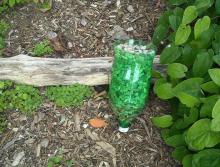
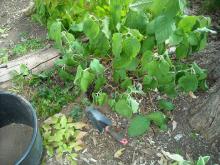
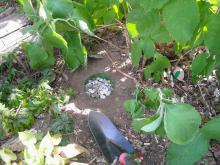
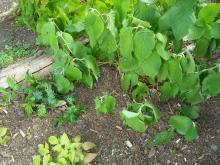
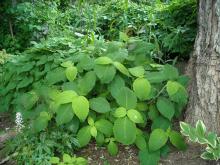
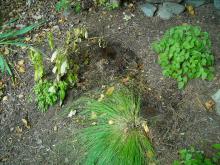
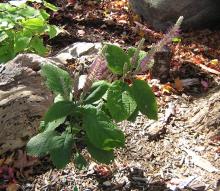
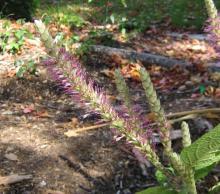
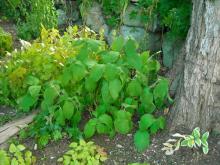
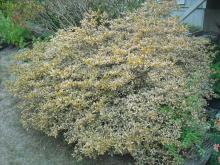
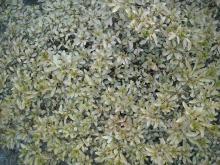
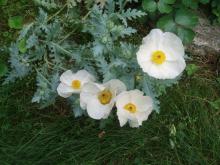
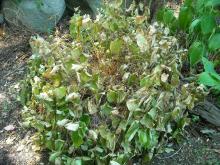
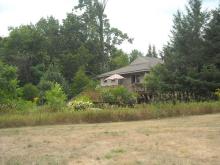
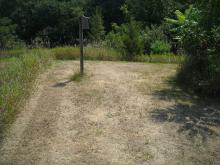
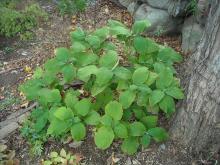
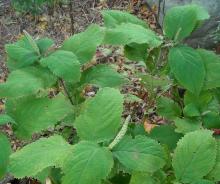
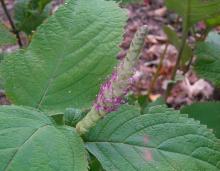
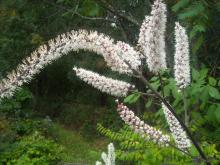
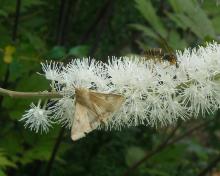
Mark, I've used coir in the mix for plants that want something closer to soil with some measure of success but it's not a complete answer by any means. It just postpones the final death throes. I also tried burying a plastic box filled with spaghnum moss (no holes in the bottom), a kind of minibog as a water reservoir. Worked for a while for some white-flowering ranunculus. Since I'm not able to water at all, I grow as many dryland plants as I can (the Rockies, Turkey etc). It takes experimenting to see which ones can also handle humidity.